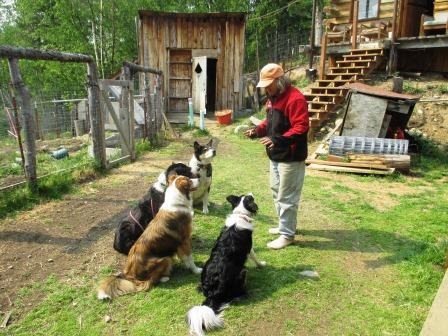
Home > Dispatches > Daily Dispatches 2017 >Daily Dispatch #79
March 20, 2017: The Horse and Human Life: Using the Clicker
The click, which is the sound that comes from either the hand-held device or the mouth, when utilized, is a way of saying yes, to the horse, dog, chicken; it says “you engaged in the right behavior.” And in saying “yes,” the one clicking is both creating new neural pathways, which form brain maps, and stimulates the amygdala, the pleasure center of the brain. For me, the use of the clicker complements my animal training philosophy, the heart of which is the use of positive reinforcement training and the exclusive use of this in modifying animal behavior for the better. I am attempting to broaden my world view in relation to positive reinforcement training, and am working at applying what I have learned to my interactions with human beings. This is a really tall order. |
|
This is not my best writing because I am in the process of making some huge cognitive leaps. But I will continue on, and do the best I can do. Horses do not have fully developed prefrontal cortexes. Humans, not horse, plan, scheme, connive. Horses are pretty much in the moment, as in there is hay in that shed and you are standing between me and it, and I want it now. This morning I used the clicker and positive reinforcement training in working with the horses, most specifically in going to get them their morning hay. It went fairly well. It sure felt better than whapping on them with the crop. Raudi was the best because she’s had the most of this kind of training. After feeding and cleaning up, I came back inside. There is that world and there is this world. I immediately snapped at Pete because he hadn’t given the chickens and goats fresh water, and was going to tell me to do this. I stomped and stormed around some. I was, I sensed, being the antithesis of my clicker training self. Pete went ahead and took care of the supposed problem. I sat down and drank some tea and began eating the breakfast that Pete had prepared for us both. And I immediately felt better. In eating, I activated my parasympathetic nervous system (rest and relaxation) and deactivated my sympathetic nervous system (flight and fight). The parallel here is that the same thing happens when the horses eat. And as with the horses, as was with me, all was right with the world. And because all was right with the world, I began saying nice things to Pete – things that I actually meant. And as I did this, I saw his face muscles relax. I was indeed, putting positive reinforcement theory to work. The rest of our morning was peaceful and calm – the way it often is but should always be. This, my making the connection between my indoor and outdoor lives is huge. The first steps in this direction center around recognition and acknowledgement. The next step will involve making a concerted effort in putting theory to practice. |
|
